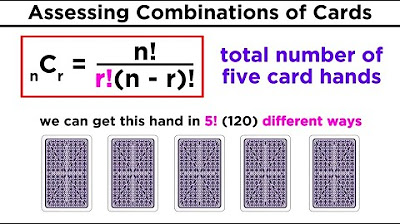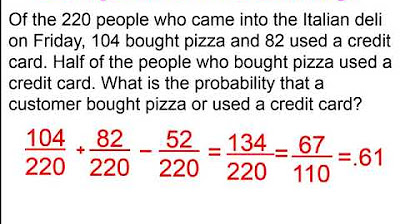Compound Probability of Independent Events - Coins & 52 Playing Cards
TLDRThis educational video delves into the concept of compound probability, focusing specifically on independent events. It begins by explaining how the probability of two independent events occurring is the product of their individual probabilities. Through clear examples, it demonstrates calculating the probability of getting heads twice in coin flips, achieving a specific sequence in multiple coin flips, and selecting particular cards from a standard 52-card deck. The video also emphasizes the importance of considering order and replacement in probability calculations, offering insights into strategies for solving more complex problems involving dependent events. Viewers are guided through a step-by-step process, enhancing their understanding of probability through practical and theoretical examples.
Takeaways
- 😀 For independent events, the probability of both events occurring is the product of the individual probabilities.
- 📝 To find the probability of multiple coin flips, write out the sample space and count the desired outcomes.
- 🎲 The probability of getting heads twice when flipping 2 coins is 1/4.
- 🌀 When order matters, multiply the individual probabilities for each outcome.
- 🎰 The probability of HTH when flipping 3 coins is 1/8.
- ♦️ A standard deck has 4 suits of 13 cards each for 52 total.
- 👑 There are 4 queens out of 52 cards, so the probability of drawing a queen is 1/13.
- 🃏 Black cards between 4-9 have a 3/13 probability.
- ❤️ Dependent events must be calculated separately then added.
- 🎴 The probability of drawing a red king then diamond is 25/2652.
Q & A
What is the formula for finding the probability of two independent events occurring?
-The probability of two independent events both occurring is equal to the probability of event A occurring multiplied by the probability of event B occurring. P(A and B) = P(A) x P(B).
How can you confirm the probability of getting two heads when flipping two coins?
-You can confirm it by writing out the sample space - HH, HT, TH, TT. There is 1 outcome out of 4 total that results in two heads, so the probability is 1/4.
Does the order of outcomes matter when finding the probability of getting two tails and one head?
-No, the order does not matter for this problem. We just need to count the number of outcomes with two tails and one head regardless of order.
How many cards are there in a standard 52-card deck?
-There are 52 cards in a standard deck - 13 cards in each of the 4 suits (diamonds, hearts, spades, clubs).
How many queen cards are there in a deck of 52 cards?
-There are 4 queen cards - the queen of diamonds, hearts, spades, and clubs. So out of 52 total cards, there are 4 queens.
Why can't you just multiply the probabilities when selecting cards without replacement?
-When selecting cards without replacement, the probabilities change after each card is drawn. So you can't just multiply the individual probabilities, you must consider the conditional probability at each step.
What is the probability of selecting a black card between 4 and 9?
-There are 6 cards between 4 and 9 in each black suit (clubs and spades). So there are 12 total cards that meet the criteria out of 52 total cards. The probability is 12/52 = 3/13.
How many red king cards are there in a deck of 52 cards?
-There are 2 red king cards - the king of diamonds and king of hearts. The other two kings (spades and clubs) are black.
Why did the solution break the red king + diamond problem into two cases?
-It broke it into selecting the red king of hearts vs the red king of diamonds because those two cases have different probabilities for the second draw of a diamond card.
What is the final simplified probability of drawing a red king and then a diamond?
-The final simplified probability is 25/2652.
Outlines
🎲 Understanding Compound Probability with Independent Events
This section introduces the concept of compound probability through the lens of independent events, illustrating how the probability of two independent events occurring together can be calculated by multiplying their individual probabilities. It uses the example of flipping a coin twice to find the probability of getting heads both times. The probability of each flip resulting in heads is 1/2, leading to a compound probability of 1/4 for getting heads on both flips. This is confirmed by listing out all possible outcomes of flipping a coin twice, showing that only one out of four outcomes is heads on both flips. The section further explores flipping a coin three times to get a specific sequence of heads and tails, demonstrating how the order of outcomes affects the calculation of probability.
🃏 Probability Calculations with a Standard 52-Card Deck
This segment delves into probability questions involving a standard 52-card deck, devoid of jokers and comprising diamonds, hearts, spades, and clubs. Each suit has 13 cards, making up the deck. The video explains how to calculate the probability of drawing a queen from the deck, showing that with four queens in total, the probability is 1/13 or approximately 7.69%. It further discusses the probability of drawing a black card with a value greater than three but less than or equal to nine, considering both clubs and spades suits. The calculation reveals a probability of 3/13 for this event, providing a practical example of how to approach and solve probability questions using a deck of cards.
🔢 Advanced Probability: Conditional and Combined Events
This part focuses on more complex probability scenarios involving conditional and combined events, using the example of drawing cards from a deck without replacement. It illustrates how the probability of selecting a red king and then a diamond card changes based on the order and outcome of the events, showing the dependency between events. The video breaks down the problem into two scenarios: selecting a red king of hearts followed by any diamond card, and selecting a red king of diamonds followed by another diamond card. By calculating the probabilities of these individual scenarios and summing them, the video demonstrates how to navigate conditional probabilities and underscores the importance of considering event dependency in probability calculations.
Mindmap
Keywords
💡Compound Probability
💡Independent Events
💡Sample Space
💡Favorable Outcomes
💡Standard 52 Card Deck
💡Without Replacement
💡Dependent Events
💡Order Matters
💡Probability Calculation
💡Favorable vs. Total Outcomes
Highlights
First significant research finding
Introduction of new theoretical model
Discussion of limitations and future work
Transcripts
5.0 / 5 (0 votes)
Thanks for rating:





